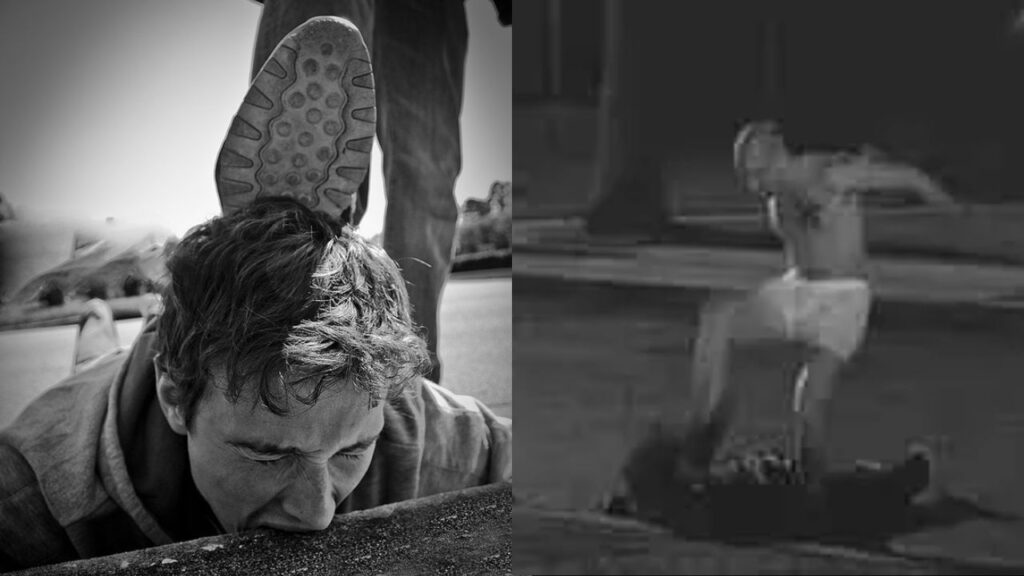Curb stomping, a vicious and often fatal form of assault, has left countless victims with severe physical injuries and deep psychological scars. This brutal act involves forcibly placing a person’s open mouth onto a curb and then stomping on the back of their head, causing catastrophic damage. In this blog post, we will know the harrowing reality of curb stomping, its origins, the devastating aftermath for victims, and the urgent need for prevention.
Curb Stomp – What Is It & Origins?
Curb stomping is a heinous act of violence that has been depicted in films and, tragically, carried out in real life. The origins of this brutal practice are unclear, but it gained notoriety in the late 20th century. Curb stomping involves forcing a victim to bite down on a concrete curb, often by kicking the back of their knees, and then violently stomping on the back of their head. This action can cause the victim’s teeth to break, jaw to shatter, and skull to fracture, leading to severe brain damage or death.

Physical Curb Stomp Aftermath
The physical aftermath of a curb stomp attack can be catastrophic and life-altering. Victims often suffer from a range of severe injuries, including:
- Jaw fractures: The forceful impact can shatter the victim’s jaw, requiring extensive surgical repair and long-term rehabilitation.
- Loss of teeth: The violent collision with the curb can cause teeth to break, become dislodged, or be completely knocked out.
- Mouth damage: The soft tissues of the mouth, including the tongue, gums, and cheeks, can be lacerated, torn, or severely bruised.
- Brain trauma: The powerful blow to the head can cause traumatic brain injury (TBI), leading to cognitive impairments, memory loss, and personality changes.
- Skull fractures: The force of the stomp can fracture the victim’s skull, potentially causing bleeding inside the skull and life-threatening complications.
- Spinal fractures: In some cases, the impact can fracture vertebrae in the victim’s spine, resulting in paralysis or even death.
Legal Repercussions Of A Curb Stomp
Curb stomping, although not a separate crime by itself, leads to serious legal consequences due to its violent nature. The charges typically depend on how badly the victim is hurt and what the person who did it meant to do. Aggravated assault charges come when the victim has serious injuries but survives, often because a deadly weapon like a curb and the attacker’s foot caused significant harm.
Attempted murder charges might happen if the injuries are life-threatening or if there’s proof the person tried to kill someone, like by repeatedly stomping on them. The punishment for these crimes changes by where you are, but it often means going to prison for a long time, sometimes for life if it’s attempted murder.
There are usually big fines and a permanent criminal record, which can make it hard to get a job, a place to live, or go to school in the future. If hate was part of why it happened, there might be more charges called hate crimes. People who’ve been curb stomped can also try to get money back through lawsuits for things like medical bills, lost pay, and how they feel.
Curb Stomp Psychological Effects
In addition to the physical trauma, curb stomp victims often experience profound psychological effects. Post-Traumatic Stress Disorder (PTSD) is common, with victims reliving the horrific event through flashbacks and nightmares. Depression, anxiety, and social withdrawal are also prevalent, as victims grapple with the emotional impact of the assault. The road to psychological recovery can be long and challenging, requiring professional counseling and support.
Preventing Curb Stomp
Preventing curb stomp incidents requires a multi-faceted approach involving community education, policy changes, and personal safety measures. Community leaders and organizations must work to raise awareness about the devastating consequences of this violent act.
Schools and youth programs should incorporate lessons on conflict resolution and the importance of respecting others. Policymakers must enact laws that impose strict penalties for curb stomping and provide support for victims. Individuals can take steps to protect themselves by being aware of their surroundings, avoiding confrontations, and learning self-defense techniques.
Real Life Curb Stomp Incidents
Tragically, curb stomping is not just a fictional horror but a reality that has claimed lives and left victims with permanent injuries. In 2002, 16-year-old Marinus Schöberl was brutally murdered by young neo-Nazis in Germany, who curb stomped him and left him to die.
In 2003, Randall Townsend was curb stomped to death in Tacoma, Washington, by a group of assailants. In 2011, Dane Hall was assaulted outside a gay bar in Salt Lake City, Utah, suffering severe injuries from a curb stomp attack. These incidents serve as stark reminders of the urgent need to address and prevent this form of violence.
Call For An Emergency
If you witness a curb stomp incident or any other violent assault, it is crucial to call for emergency services immediately. Dial 911 or your local emergency number and provide the operator with as much information as possible, including the location, number of assailants, and the victim’s condition.
If it is safe to do so, stay with the victim until help arrives, offering comfort and support. Remember, your quick action could save a life.
Conclusion
Curb stomping is a brutal and life-altering form of violence that leaves victims with severe physical injuries and deep psychological scars. By understanding the devastating aftermath of this heinous act, we can work together as a society to prevent future incidents. Through community education, policy changes, and personal safety measures, we can strive to create a safer world where no one falls victim to the horror of a curb stomp attack.
Let us stand united in our commitment to end this senseless violence and support those who have been affected by it.